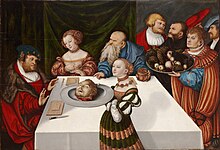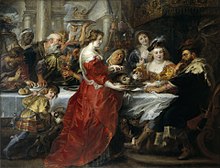Herodias

Herodias (Template:Lang-el, Hērōdiás; c. 15 BC — after 39 AD) was a princess of the Herodian Dynasty of Judaea during the time of the Roman Empire.[1][2]
Family relationships
- She was the daughter of Aristobulus IV and his wife Berenice.
- Her first husband was the son of Herod the Great and his third wife, Mariamne II.
- Her mother Berenice was the daughter of Herod's sister Salome I, and of Costabarus, governor of Idumea.
- Full sister to Herod V (king of Chalkis), Herod Agrippa (king of Judea), Aristobulus Minor, and Mariamne III (wife of Crown Prince Antipater and, after his execution by Herod the Great, she was possibly the first wife of Herod Archelaus, principal heir of Herod the Great and ethnarch of Judea).
- Daughter-in-law of Herod the Great, twice: once by marriage to his son, Herod II, and again by marriage to another son, Herod Antipas.
Marriages



Herod II
Herod II (born - ca. 27B.C.; died - 33A.D.)[3] was the son of Herod the Great and his third wife Mariamne II, who was the daughter of Simon Boethus the High Priest.[4] For a brief period he was his father's heir. Some writers call him Herod Philip I (not to be confused with Philip the Tetrarch, whom some writers call Herod Philip II).
Herod was the first husband of Herodias, and because the Gospel of Mark states that Herodias was married to Philip, some scholars have argued that his name was actually Herod Philip. Many scholars dispute this, however, and believe the Gospel writer was in error, a suggestion supported by the fact that the later Gospel of Luke drops the name Philip.[5][6] Because he was the grandson of the high priest Simon Boethus he is sometimes described as Herod Boethus, but there is no evidence he was actually called this.[7]
Herod the Great's execution of his Hasmonean sons, Alexander and Aristobulus IV in 7 B.C., left the latter's daughter Herodias an orphaned minor. Herod engaged her to Herod II, her half-uncle, and her connection to the Hasmonean bloodline supported her new husband's right to succeed his father.
This marriage led to opposition from Antipater II, Herod the Great's eldest son, and so Herod demoted Herod II to second in line to the succession. Antipater's execution in 4 B.C. for plotting to poison his father seemed to leave Herod II, now Herod I's eldest surviving son, as first in line, but his mother's knowledge of the poison plot, and failure to stop it, led to his being dropped from this position in Herod I's will just days before he died.
Herodias later divorced Herod II, although it is unclear when they were divorced. According to the historian Josephus:
Herodias took upon her to confound the laws of our country, and divorced herself from her husband while he was alive, and was married to Herod Antipas[8]
According to biblical scholars, the Gospel of Matthew [9] and the Gospel of Luke [10] indicate that it was this proposed marriage which John the Baptist publicly criticized. Josephus does not say this but these events (the divorce, the marriage, execution, and the resulting war with Aretas IV Philopatris, King of the Nabataeans[11]) chronologically give weight to this theory, suggesting the events are linked.
Salome
Herod II and Herodias had a daughter named Salome, although some scholars indicate that some Greek texts show that Salome may have also been called Herodias like her mother, but was referred to as Salome in order to avoid confusion.[12] As Josephus reports in Jewish Antiquities (Book XVIII, Chapter 5, 4):
Herodias, [...], was married to Herod, the son of Herod the Great by Mariamne II, the daughter of Simon the High Priest. [Herod II and Herodias] had a daughter, Salome...[8]
Some ancient Greek versions of Mark read "Herod's daughter Herodias" (rather than "daughter of the said Herodias").[12] To scholars using these ancient texts, both mother and daughter had the same name. However, the Latin Vulgate Bible translates the passage as it is above, and western Church Fathers therefore tended to refer to Salome as "Herodias's daughter" or just "the girl."
Christian traditions depict her as an icon of dangerous female seductiveness, for instance depicting as erotic her dance mentioned in the New Testament (in some later transformations further iconised to the dance of the seven veils), or concentrate on her lighthearted and cold foolishness that, according to the gospels, led to John the Baptist's death. (This Salome is not to be confused with Salome the disciple, who was a witness to the Crucifixion of Jesus in Mark 15:40.)
Herod Antipas
Herod Antipas (born before 20 B.C.; died after 39 A.D.) was also the son of Herod the Great by his fourth wife, Malthace, and half-brother of Herod II. He was a ruler of Galilee and Perea, who bore the title of tetrarch ("ruler of a quarter"). He is best known today for accounts in the New Testament of his role in events that led to the executions of John the Baptist and Jesus of Nazareth.
Antipas divorced his first wife Phasaelis, the daughter of King Aretas IV of Nabatea, in favor of Herodias. According to the New Testament Gospels, it was John the Baptist's condemnation of this arrangement that led Antipas to have him arrested: John was subsequently put to death. Besides provoking his conflict with the Baptist, the tetrarch's divorce added a personal grievance to previous disputes with Aretas over territory on the border of Perea and Nabatea. The result was a war that proved disastrous for Antipas; a Roman counter-offensive was ordered by Tiberius, but abandoned upon that emperor's death in 37 A.D.. In 39 A.D. Antipas was accused by his nephew Agrippa I of conspiracy against the new Roman emperor Caligula, who sent him into exile in Gaul. Accompanied there by Herodias, he died at an unknown date.
The Gospel of Luke states that when Jesus was brought before Pontius Pilate for trial, Pilate handed him over to Antipas, in whose territory Jesus had been active. However, Antipas sent him back to Pilate.
It is uncertain if Herodias had any children by her second husband, Herod Antipas.
In the Gospels

In the Gospels of Matthew and Mark, Herodias plays a major role in John the Baptist's execution, using her daughter's dance before Antipas and his party guests to ask for the head of the Baptist as a reward. Antipas did not want to put John the Baptist to death, for Antipas liked to listen to John the Baptist preach (Mark 6:20). Furthermore, Antipas may have feared that if John the Baptist were to be put to death, his followers would riot.
Modern scholarship
At least one biblical scholar has doubted that the Gospels give historically accurate accounts of John the Baptist's execution.[13] According to the ancient historian Josephus, John the Baptist was put to death by Antipas for political reasons, for Antipas feared the prophet's seditious influence.[14] Some exegetes believe that Antipas' and Herodias' struggle with John the Baptist as told in the Gospels was some kind of a remembrance of the political and religious fight opposing the Israelite monarchs Ahab and Jezebel to the prophet Elijah.[15]
In medieval literature
In medieval Europe a widespread belief held Herodias to be the supernatural leader of a supposed cult of witches, synonymous with Diana, Holda and Abundia.[16]
In art
Together with Salome, Herodias was a frequent subject in images of the Power of Women topics in the later medieval and Renaissance period. The most common moment shown including Herodias is the Feast of Herod, showing Salome presenting John's severed head on a platter as Herodias dines with her husband and others. He often looks horrified, but she generally shows quiet satisfaction.
Herodias in fiction
- Hérodiade, opera by Jules Massenet.
- Hérodias, story by Gustave Flaubert, one of the Three Tales (Trois contes), published in 1877.
- Salome: The Wandering Jewess. My First 2,000 Years of Love, by George Sylvester Viereck, 1930.
- Salomé, play by Oscar Wilde, French (1894), translated into English by Lord Alfred Douglas, 1895.
- Salome, opera by Richard Strauss, based on a German translation (by Hedwig Lachmann, grandmother of Mike Nichols) of the play by Oscar Wilde.
- Salomé, an opera by French composer Antoine Mariotte, set to a French libretto based on Oscar Wilde's play.
- Salome, song by Irish rock band U2.
- In Parsifal, the opera by Richard Wagner, the lead female character of Kundry is revealed to be Herodias, in the second act. In the opera she was said to have laughed at Christ when she saw him being crucified and was cursed with immortality. She eventually finds redemption through the actions of Parsifal.
- Herodias is the name of an outcast devil in the Dungeons & Dragons roleplaying game.
References
- ^ Herodian Dynasty
- ^ http://www.perseus.tufts.edu/hopper/text?doc=Perseus%3Atext%3A1999.01.0239%3Abook%3D16%3Achapter%3D2%3Asection%3D34
- ^ Kokkinos, The Herodian Dynasty, p. 237
- ^ Mark 6:17
- ^ However, it seems more likely that the Bible writer Luke simply didn't include the name, as it wasn't important to the account..Harold Hoehner, Herod Antipas: A Contemporary of Jesus Christ (Zondervan, 1983), page 132 - 134.
- ^ see also, for example, E. Mary Smallwood, "Behind the New Testament", Greece & Rome, Second Series, Vol. 17, No. 1 (Apr., 1970), pp. 81-99
- ^ Florence Morgan Gillman, Herodias: at home in that fox's den (Liturgical Press, 2003) page 16.
- ^ a b W. Whiston translation at Project Gutenberg
- ^ Matthew 14:3-12
- ^ Luke 3:18-20
- ^ (Josephus, Antiquities 18:116-119)
- ^ a b Taylor, V. (1966). The gospel according to St Mark, 2nd Edition. London: Macmillan (pp310ff.)
- ^ Meier, A Marginal Jew: Rethinking the Historical Jesus, Volume Two: Mentor, Message and Miracles. Anchor Bible Reference Library, New York: Doubleday, 1994, pp. 171-176.
- ^ Josephus, Jewish Antiquities, Book XVIII, Chapter 5
- ^ Florence Morgan Gillman, Herodias: At Home In That Fox's Den, page 84 (Liturgical Press, 2003). ISBN 0-8146-5108-9
- ^ Ginzburg, Carlo (1990). Ecstasies: Deciphering the witches' sabbath. London: Hutchinson Radius. ISBN 0-09-174024-X.
Further reading
- Gillman, Florence Morgan. Herodias: At Home in the Fox's Den. Interfaces. Collegeville, Minn.: Liturgical Press, 2003.
- Meier, John P. A Marginal Jew: Rethinking the Historical Jesus, Volume Two: Mentor, Message and Miracles. Anchor Bible Reference Library, New York: Doubleday, 1994.
- Theissen, Gerd. The Shadow of the Galilean: The Quest of the Historical Jesus in Narrative Form. Philadelphia: Fortress, 1987.
